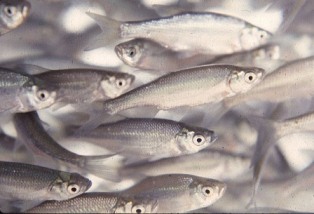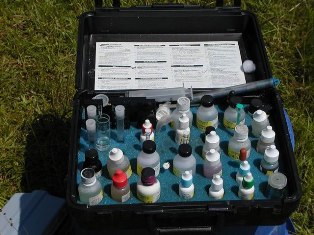David Cline, Extension Aquaculturist, Alabama Cooperative Extension System, Auburn University
Water quality is a critical factor when culturing any aquatic organism. Optimal water quality varies by species and must be monitored to ensure growth and survival. The quality of the water in the production systems can significantly affect the organism’s health and the costs associated with getting a product to the market. Water quality parameters that are commonly monitored in the aquaculture industry include temperature, dissolved oxygen, pH, alkalinity, hardness, ammonia, and nitrites. Depending on the culture system, carbon dioxide, chlorides, and salinity may also be monitored. Some parameters such as alkalinity and hardness are fairly stable, but others like dissolved oxygen and pH fluctuate daily. It is important to establish a standardized water quality testing protocol for your particular situation. Know the tolerance range for your culture species, establish critical levels, and be prepared to act if a problem occurs. The chart below indicates the water quality preferences for some commonly cultured species. For more information about a particular parameter, click one of the links below. If you need assistance in this area, contact your local Cooperative Extension office.
| Species | Temp °F | Dissolved Oxygen mg/L | pH | Alkalinity mg/L | Ammonia % | Nitrite mg/L |
|---|---|---|---|---|---|---|
| Baitfish | 60-75 | 4-10 | 6-8 | 50-250 | 0-0.03 | 0-0.6 |
| Catfish/Carp | 65-80 | 3-10 | 6-8 | 50-250 | 0-0.03 | 0-0.6 |
| Hybrid Striped Bass | 70-85 | 4-10 | 6-8 | 50-250 | 0-0.03 | 0-0.6 |
| Perch/Walleye | 50-65 | 5-10 | 6-8 | 50-250 | 0-0.03 | 0-0.6 |
| Salmon/Trout | 45-68 | 5-12 | 6-8 | 50-250 | 0-0.03 | 0-0.6 |
| Tilapia | 75-94 | 3-10 | 6-8 | 50-250 | 0-0.03 | 0-0.6 |
| Tropical Ornamentals | 68-84 | 4-10 | 6-8 | 50-250 | 0-0.03 | 0-0.5 |
Resources
Introduction to Water Chemistry for Freshwater Aquaculture (pdf).
Aquaculture Effluents: A Guide for Water Quality Regulators and Aquaculturists (pdf)
A Beginner’s Guide to Water Management (pdf)
A Fish Farmer’s Guide to Understanding Water Quality (pdf)
Algae Blooms in Commercial Fish Production Ponds (pdf)
Algal Toxins in Pond Aquaculture Ammonia in Fish Ponds (pdf)
Ammonia in Fish Ponds (pdf)
Carbon Dioxide in Fish Ponds (pdf)
Compliance Guide for the Concentrated Aquatic Animal Production Point Source Category (pdf)
Cost of Alternative Effluent Treatments for Catfish Production (pdf)
Dissolved Oxygen for Fish Production (pdf)
Growout Pond and Water Quality Management (pdf)
Idaho Waste Management Guidelines for Aquaculture Operations (pdf)
Interactions of pH, Carbon Dioxide, Alkalinity, and Hardness (pdf)
Managing Ammonia in Fish Ponds (pdf)
Managing High pH in Freshwater Ponds (pdf)
Measuring Dissolved Oxygen Concentration in Aquaculture (pdf)
Nitrite in Fish Ponds (pdf)
Plain English Instructions for Hach Water Quality Kits (pdf)
Source Water Quality for Aquaculture: A Guide for Assessment (pdf)
The Use of Lime, Gypsum, Alum, and Potassium Permanganate in Water Quality Management (pdf)
Toxicities of Agricultural Pesticides to Selected Aquatic Organisms (pdf)
Understanding Your Fish Pond Water Analysis Report (pdf)
Waste Management in Aquaculture (pdf)
Phosphorous in Rainbow Trout Effluents (pdf)
The following article can be downloaded from the North Central Regional Aquaculture Center’s website:
Aquaculture Effluents and Waste By-Products
Status and Concerns of Aquaculture Effluents in the North Central Region
Links
Fish Farmer’s Guide to Understanding Water Quality
Site Selection for Aquaculture: Chemical Features of Water
Site Selection for Aquaculture: Physical Features of Water

